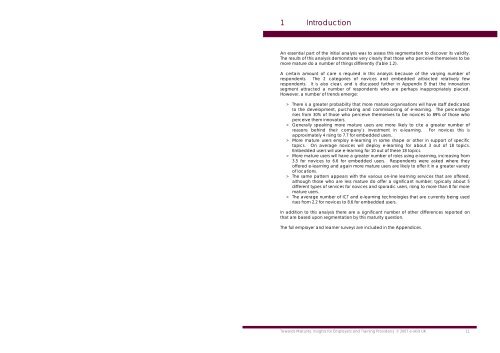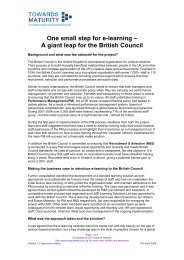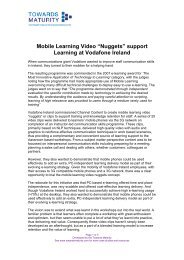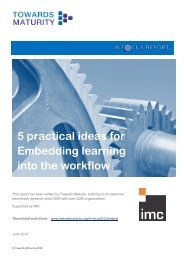Towards Maturity
Towards Maturity
Towards Maturity
You also want an ePaper? Increase the reach of your titles
YUMPU automatically turns print PDFs into web optimized ePapers that Google loves.
1 Introduction<br />
An essential part of the initial analysis was to assess this segmentation to discover its validity.<br />
The results of this analysis demonstrate very clearly that those who perceive themselves to be<br />
more mature do a number of things differently (Table 1.2).<br />
A certain amount of care is required in this analysis because of the varying number of<br />
respondents. The 2 categories of novices and embedded attracted relatively few<br />
respondents. It is also clear, and is discussed further in Appendix B that the innovation<br />
segment attracted a number of respondents who are perhaps inappropriately placed.<br />
However, a number of trends emerge:<br />
> There is a greater probability that more mature organisations will have staff dedicated<br />
to the development, purchasing and commissioning of e-learning. The percentage<br />
rises from 30% of those who perceive themselves to be novices to 89% of those who<br />
perceive them innovators.<br />
> Generally speaking more mature users are more likely to cite a greater number of<br />
reasons behind their company’s investment in e-learning. For novices this is<br />
approximately 4 rising to 7.7 for embedded users.<br />
> More mature users employ e-learning in some shape or other in support of specific<br />
topics. On average novices will deploy e-learning for about 3 out of 18 topics.<br />
Embedded users will use e-learning for 10 out of these 18 topics.<br />
> More mature users will have a greater number of roles using e-learning, increasing from<br />
3.5 for novices to 6.6 for embedded users. Respondents were asked where they<br />
offered e-learning and again more mature users are likely to offer it in a greater variety<br />
of locations.<br />
> The same pattern appears with the various on-line learning services that are offered,<br />
although those who are less mature do offer a significant number; typically about 5<br />
different types of services for novices and sporadic users, rising to more than 8 for more<br />
mature users.<br />
> The average number of ICT and e-learning technologies that are currently being used<br />
rises from 2.2 for novices to 8.6 for embedded users.<br />
In addition to this analysis there are a significant number of other differences reported on<br />
that are based upon segmentation by this maturity question.<br />
The full employer and learner surveys are included in the Appendices.<br />
<strong>Towards</strong> <strong>Maturity</strong>: Insights for Employers and Training Providers| © 2007 e-skills UK 11








